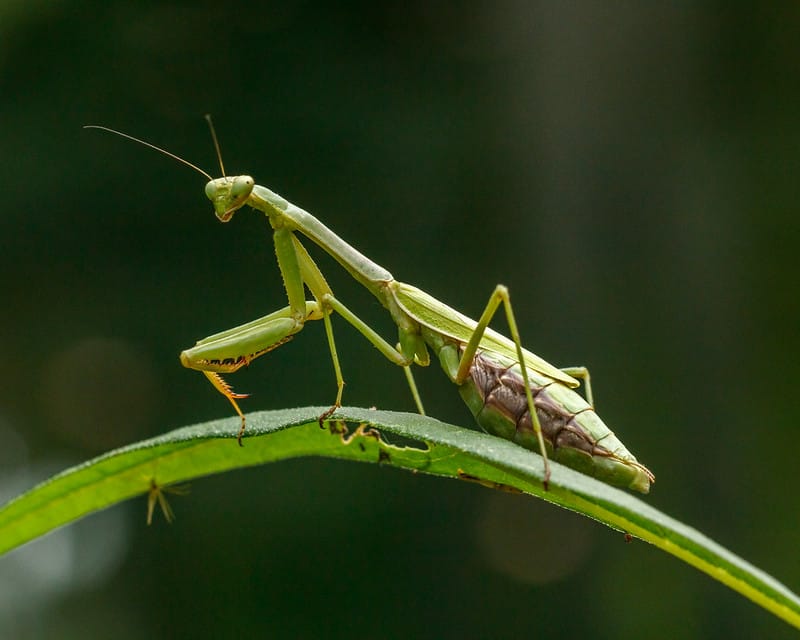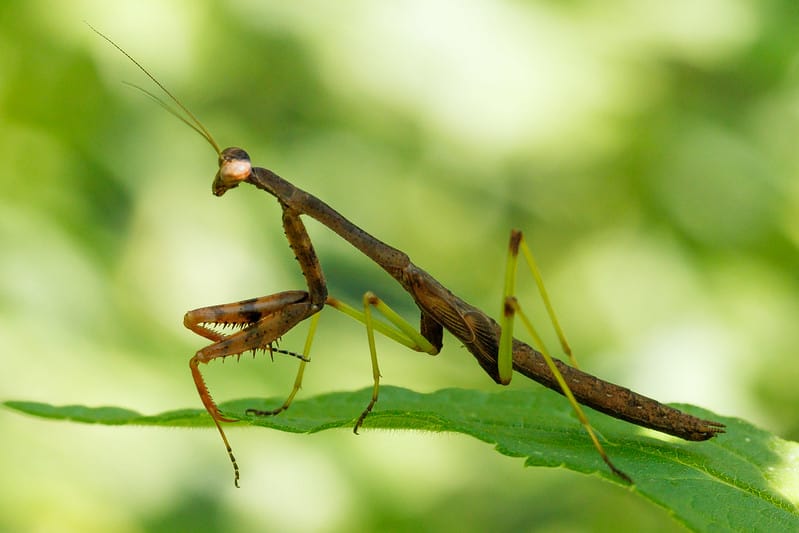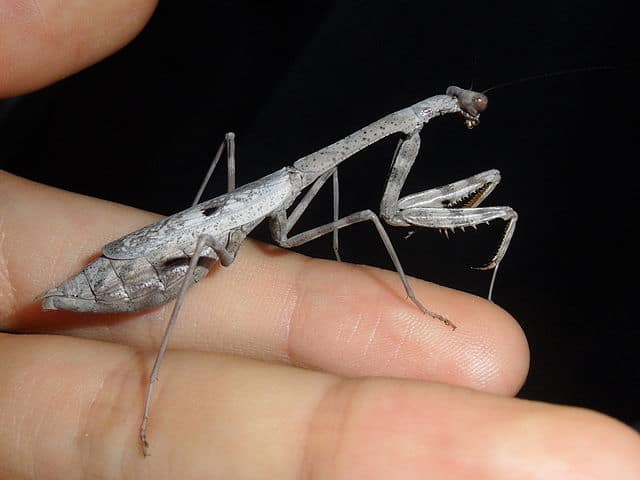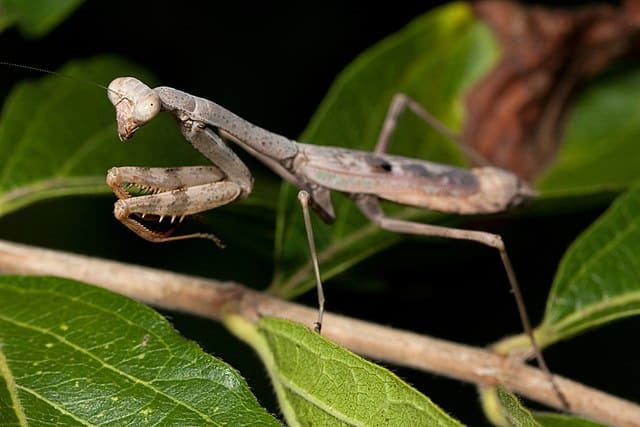The Carolina Mantis (Stagmomantis Carolina) is a beautiful Mantis species native to the American continents. It’s a stunning insect with patterns that help it resemble a twig or a branch. They’re commonly used as pest control since, unlike the Chinese Mantis, the Carolina Mantis isn’t invasive; however, they’re also often kept as interesting pets.
One of the reasons why this species is so popular in the pet trade is because they can have a variety of different colors. They can be brown, gray, green, and have spots or bands. Interestingly enough, they can even change between these colors! This, combined with their easy to care for and docile nature makes them highly desired among bug lovers.
If you’re thinking about getting a Carolina Mantis for your collection, here’s everything you need to know to properly care for them!

Carolina Mantis Care Sheet
| Name of species | Stagmomantis carolina |
| Family | Mantidae |
| Common name | Carolina Mantis |
| Category | Mantis |
| Type | Macropterous |
| Native location | The Americas |
| Size | 2 to 2.5 inches (4.7 to 6 cm) |
| Diet | Small flying insects |
| Lifespan | 10-12 Months |
| Experience level | Beginner |
Carolina Mantis Overview

The Stagmomantis carolina is commonly known as Carolina Mantis by people both in and out of the insect-keeping hobby. They’re native to the Americas, and you can find them in the vast territory that starts in Brazil and extends up to the USA.
They’re classified as Macropterous, meaning they have long wings that can be used for flying. They mainly feed on flying insects, so they’ll be happy eating flies in captivity.
Appearance & Variants
You’ll easily recognize the Carolina Mantis as a member of the mantid family due to its characteristic appearance. Slender bodies, forest colors, and two razor-like arms stretching at the front of their bodies make them distinct members of the Mantid family.
In the case of the Carolina Mantis, it’s a small and beautiful insect that may display different colors and patterns. Grey, brown, and green are some of the most common tones in which you may find this species; however, they’re seldom monochromatic, and you’ll often see them with beautiful patterns that resemble bark and branches in their thorax and abdomen.
This great variety of displays happens thanks to its natural adaptation to its environment. The CM nymphs adapt their color to the environment they’re in at the time of molting, so you’ll be able to make it adopt your favorite color once you get used to caring for them.

This species displays sexual dimorphism, so a trained eye can easily tell males from females. First of all, males are smaller, with thinner bodies and longer wings. Females, on the other hand, are bigger, bulkier, and have shorter wings than males.
Males and females both have a black dot at the middle of their outer wings, which is often an easy way to recognize them as a species.
As far as size goes, a fully grown Carolina Mantis typically tops out at a size of around 2 to 2.5 inches.
Price
The Carolina Mantis isn’t difficult to find in the US, so you’ll get the chance to buy it in many different stages of development.
If you’re interested in raising your own batch from an Ootheca (a collection of eggs), getting one will cost you between $25 to $30.
A nymph will often cost the same, and it’s the most popular choice for people only interested in having one specimen since you’ll get to see its whole lifecycle.
Adult CMs will often be less expensive, ranging from $15 to $20; the cost is lower because there’s no guarantee of how long your Mantis has to live, which is why nymphs are so popular.
However, nymphs are harder to take care of and keep alive, so if you’re a complete beginner, getting an adult first may be the best choice for you before moving on to taking care of Ooths or Nymphs.
Behavior and Temperament
As it happens with most Mantids, the Carolina Mantis is a cannibalistic species, so you shouldn’t place it in a communal enclosure, or else they’ll prey on each other until there’s only one left.
The CM is also an amazing hunter with a fantastic feeding response, so feeding time is never boring with them. Besides this, the CM is a peaceful and docile insect, so handling them is easy if that’s what you’re interested in.
Of course, as is the case with all Mantids, this species is harmless to humans as it’s neither venomous nor strong enough to slice your skin.
While handling them, you only need to be careful not to put too much pressure on them so you do not accidentally crush them.
They’re particularly vulnerable four days after a molt, so don’t try to handle them during that time.
Caring for a Carolina Mantis

Temperature and Humidity
The Carolina Mantis is used to the high temperatures and humidity of its same-name state. Therefore, temperatures of 70°F to 85°F and humidity levels of 70% to 80% are the best for them.
Of course, to reach those environmental characteristics, you’ll need constant misting, and good ventilation is also required to keep them healthy under those temperatures.
Substrate
The CM doesn’t need too much substrate, so one or two inches will be enough to keep them comfortable.
Some people use moist paper towels as a substrate, especially when they’re nymphs, to keep the humidity up.
However, as they grow into adulthood, an adequate substrate is preferred to keep them comfortable and happy.
You may go for mixtures including topsoil and peat moss, as it’s ideal for moisture retention.
You can also aim for having a bioactive enclosure, in which case you’d want to add organic soil to the mix to keep the plants healthy.
Tank Setup
When finding an ideal enclosure for your Carolina Mantis, ventilation is critical. If your tank’s walls are solid, make sure that at least 20% of them are either a mesh or pierced by ventilation holes.
Regarding the size, the ideal tank should be at a minimum three times as long and high as the mantis itself. It should also be twice as wide as the mantis. However, it’s ideal to give your CM more space by getting an even bigger tank.
As for decoration, this species loves being able to climb and hide. Always have a twig or a branch inside the enclosure for its comfort. Also, depending on whether you’re going for a bioactive or sterile ecosystem, silk plants or living plants will also improve the tank’s beauty while also making it more comfortable for the mantis.
Watering
The Stagmomantis carolina needs plenty of humidity in the tank, so you should consider misting it every day to keep it comfortable.
Sometimes you’ll need to mist the enclosure twice per day, and it’s important to point out that regular tap water isn’t safe for your CM. You’ll need to use water without fluorine or other additives, so distilled water is a great choice for them.
Other than this, they’ll get most of their hydration from their food. However, you’ll often see them drinking droplets of water from the twigs or walls, reinforcing the need for frequent misting.
Diet and Feeding
Feeding a Carolina Mantis is fairly easy. They’ll eat any flying insects, so flies are an inexpensive and great choice to keep them healthy. L1 and L2 nymphs should be fed small fruit flies. L3 and L4 nymphs love large fruit flies, and L5 to adults enjoy having house flies or blue bottle flies. Additionally, adult specimens also enjoy eating other small insects such as crickets and grasshoppers.
Feed them once every three days for as much as they can eat, and keep a close eye on their abdomens to make sure you’re not overfeeding or underfeeding them. As long as their abdomen doesn’t get too bulky or flat, you’ll know it’s healthy.
You may change their diet by adding moths or other small flying insects; just make sure to never add crickets as they often carry viruses and bacteria that may be deadly for Mantids.
Molting
Every mantis species will molt several times throughout its life, and the Stagmomantis carolina is no exception. During the molt, make sure that you do not disturb them as this is a stressful process for them.
When molting, it’s important that the enclosure is humid enough. If not, it’s possible for the insect to lose a limb and generally the molting process will be more difficult
You might notice that your mantis will not eat right before a molt. This is normal behavior and is done because it makes the molting process easier. Additionally, they will typically not eat for a while after a molt because they need time for their exoskeleton to harden.
Lifespan & Health

The Carolina Mantis is a relatively healthy and hardy insect. It has an average lifespan of 10 to 12 months when properly cared for. In captivity, not much prevents them from reaching their full lifespan.
To keep your CM healthy, make sure that you feed them high-quality food from a reputable seller. The feeder insects you give them should be captive-bred, not wild-caught. Wild-caught feeder insects can contain parasites and other bacteria that can negatively impact your mantis.
Fun Facts about the Carolina Mantis
- The Carolina Mantis was named the State Insect of South Carolina in 1988. It’s not the only insect that represents that state, as South Carolina also named the Eastern Tiger Swallowtail its State Butterfly.
- As it happens with most Mantids, the CM is prone to cannibalism if the opportunity presents itself. Around 25% of all mating attempts on this species result in cannibalism; in these cases, the female will eat the male’s head and leave the rest of the body to eat after the mating is finished.
- It’s common to call these insects a Praying Mantis instead of just Mantis. It became part of popular culture thanks to the way it holds both front legs in front of its body. However, this is wrong, as they should be called Mantis (or Mantids in plural).
Final words: Is the Carolina Mantis right for you?
The Carolina Mantis is a lovely addition to your collection. It’s also a great way to get into exotic pets as it’s easy to get and care for.
A common favorite among kids, the CM is a great choice for all experience levels; but it’s particularly good for beginners. Nevertheless, even for more experienced insect keepers the Carolina Mantis is a great choice. Their large color variety gives them a very interesting appearance and their strong feeding response make them a joy to have for any bug collector.
- How Long Do American Eskimo Dogs Live? Important Factors and Care Tips - September 29, 2023
- Do American Bulldogs Need Grooming? Essential Tips and Care Guidelines - September 29, 2023
- Do Bengal Cats Enjoy Playing? Essential Tips for Keeping Them Active - September 29, 2023